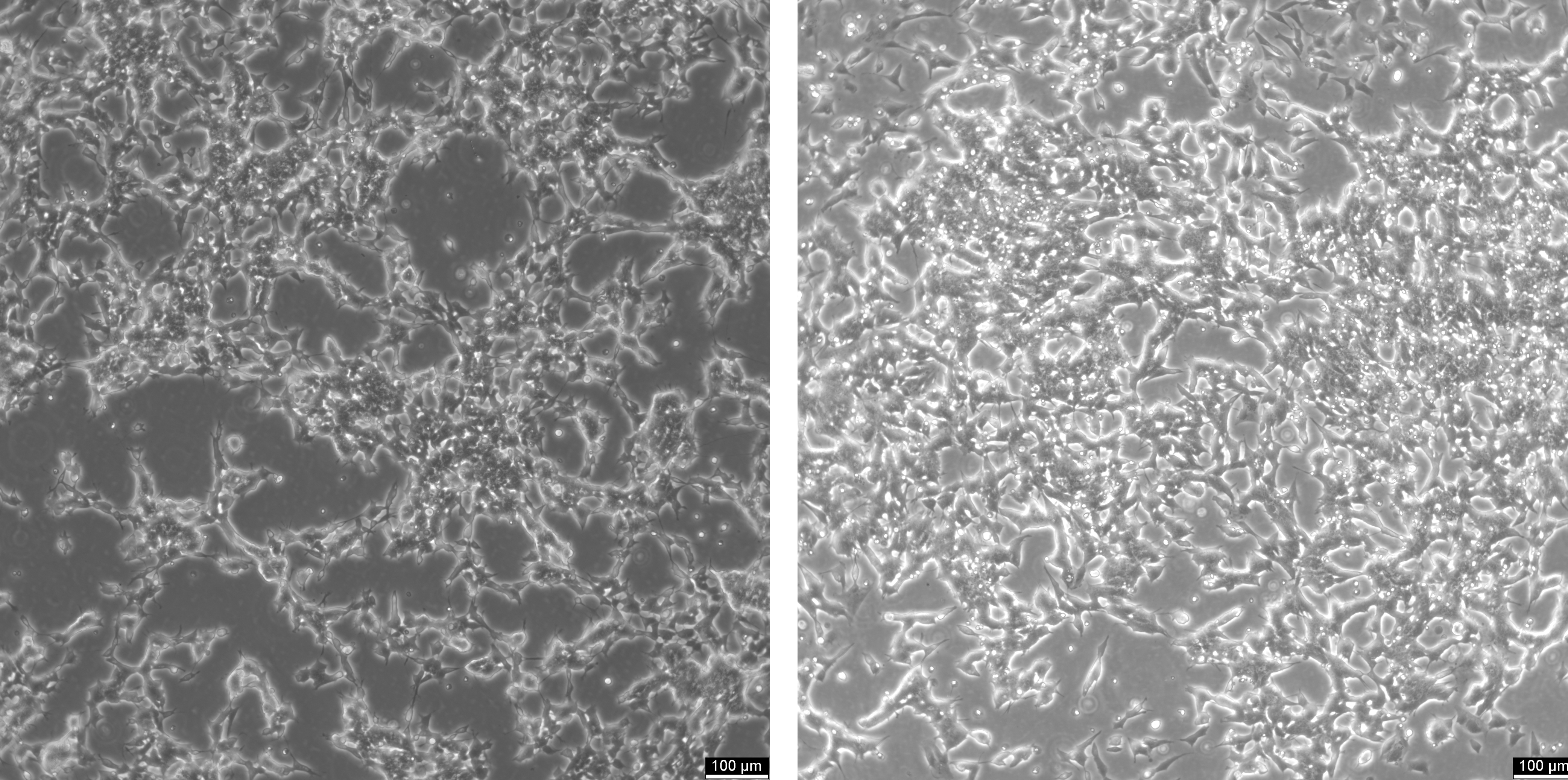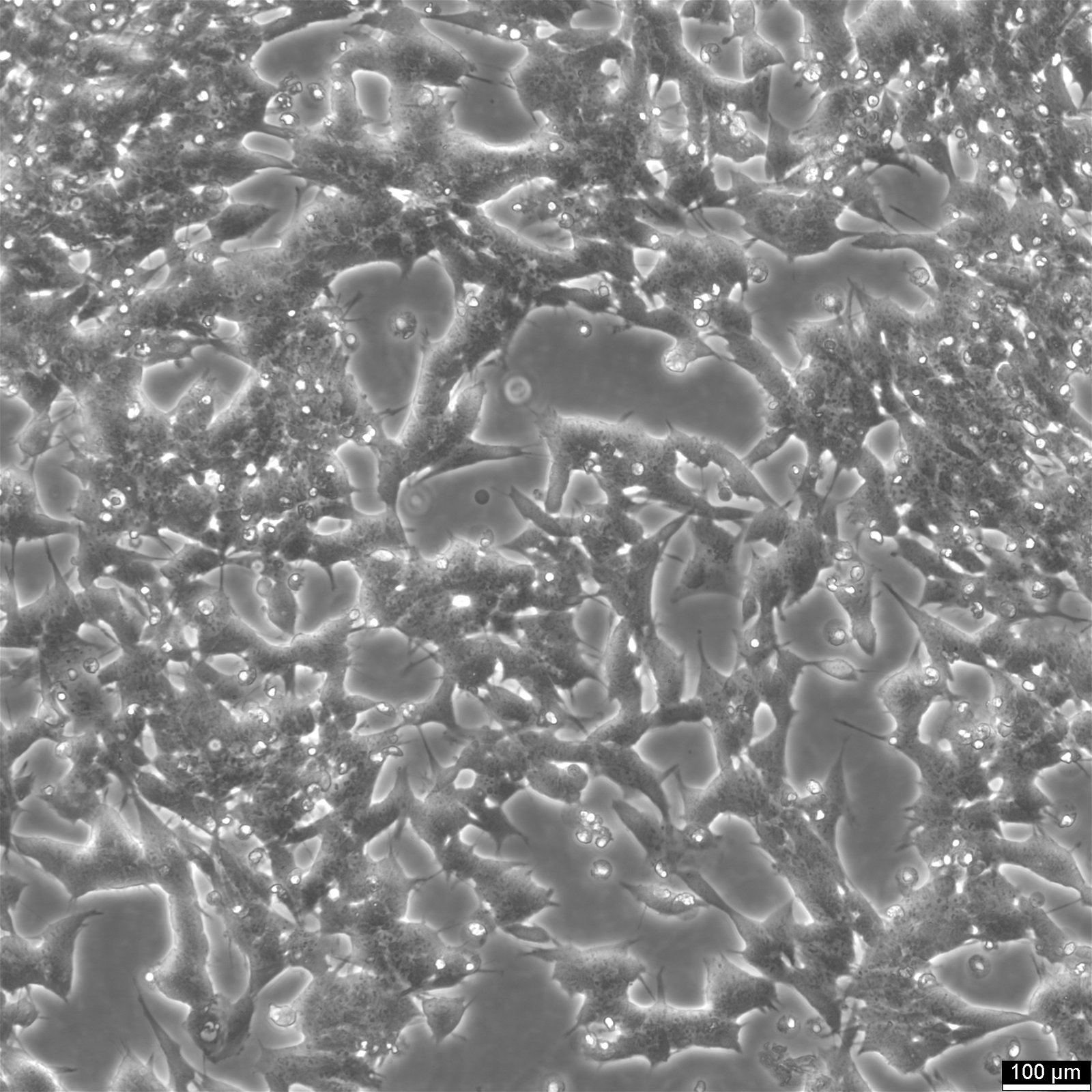SH-SY5Y Cells - Neuroblastoma Research and the Neuroscientific Relevance of SH-SY5Y Cells
The SH-SY5Y cell line, derived from human neuroblastoma, is extensively utilized in medical research for investigating neurodegenerative diseases and developing drugs. Researchers employ these cells in their original undifferentiated form or differentiate them into cells resembling neurons.
General information and origin of the SH-SY5Y cell line
This section will cover basic information about the SH-SY5Y cell line, including its origin, definition, and cellular structure. We will address questions such as its morphology and the cells' origin.
- SH-SY5Y is a human-derived cell line that originated from subcloning of the SK-N-SH neuroblastoma cell line in 1970.
- The parent cell line, SK-N-SH, was developed from the bone marrow biopsy of a four-year-old female neuroblastoma patient.
- SH-SY5Y cells are phenotypically adrenergic and express dopaminergic markers, making them a useful in vitro model for studying neurodegenerative diseases, neurogenesis, and brain cell characteristics [1].
- SH-SY5Y cells grow as clumps of viable neuroblastic cells with neurites and are loosely adherent.
- The cell size of SH-SY5Y cells is 12 μm.
- The modal chromosome number for SH-SY5Y cells is 47, and they possess a rare marker of chromosome number 1, trisomy of 1q, caused by the insertion of an extra copy of the 1q segment into the long arm of chromosome 1.
Culturing SH-SY5Y Cells
In neurobiological research labs, SH-SY5Y cells are the most cultured neuroblastoma cells. To work with these cells, it is essential to understand what type of growth medium is suitable for their culture, their growth characteristics, optimal seeding density, and the proper method for freezing them. This section will provide essential information on culturing SH-SY5Y cells to assist you with these aspects.
Key Points for Culturing SH-SY5Y Cells
|
Population Doubling Time: The mean population doubling time for SH-SY5Y cells is approximately 3 to 4 days. |
|
Adherent or in Suspension: SH-SY5Y are loosely adherent cells. They grow as clumps when seeded at a high density. |
|
Seeding Density: The optimal seeding density for SH-SY5Y is 1 x 104 cells/cm2. SH-SY5Y cultures consist of both adherent and floating cells. |
|
Growth Medium: DMEM:Ham's F12 media supplemented with 3.1 g/L glucose, 10% FBS, and 1.6 mM L-glutamine is ideal for growing the SH-SY5Y cell line. |
|
Growth Conditions (Temperature, CO2): SH-SY5Y cells are grown at 37°C temperature in a humidified incubator with a 5% CO2 supply. |
|
Storage: To maintain the viability of SH-SY5Y cells, they are stored in the vapor phase of liquid nitrogen at below -150°C temperature. |
|
Freezing Process and Medium: CM-1 or CM-ACF freezing media are used to freeze SH-SY5Y cells. A slow freezing method that gradually drops the temperature by 1°C is opted for freezing this neuroblastoma cell line. |
|
Thawing Process: Frozen vials containing SH-SY5Y cells are placed in a water bath set at 37°C temperature. The vial is rapidly agitated until cells thaw, and only a small ice clump is left. |
|
Biosafety Level: SH-SY5Y cells can be cultured in a biosafety level 1 laboratory. |
SH-SY5Y cells: Advantages & Limitations
Advantages
- Differentiation into Neurons: SH-SY5Y cells can be differentiated into functional neurons using specific compounds, providing a more convenient alternative to primary neurons and avoiding ethical concerns associated with their use [2].
- In Vitro Model for Neurodegenerative Diseases: The expression of molecular markers, including dopaminergic neural markers, makes SH-SY5Y cells suitable for studying neurodegenerative disorders like Parkinson's.
Limitations
- Unsynchronized Cell Cycle: SH-SY5Y cell cultures exhibit unsynchronized cell cycles in an undifferentiated state [3].
- Undefined Differentiation State: SH-SY5Y cells have an undefined differentiation state that ranges from a tumorigenic neuroblastoma state to postmitotic neurons or neural progenitor cells. They do not express molecular markers that mature neuron cells do [4].
SH-SY5Y Cells for In Vitro Neuropharmacology & Drug Discovery
Applications of SH-SY5Y cells
Neurodegenerative Disease Research: SH-SY5Y cells are utilized to study neurodegenerative disorders, such as Alzheimer's and Parkinson's disease. For example, a study treated SH-SY5Y cells with amyloid β peptide 1-42 to establish an in vitro model of Alzheimer's disease. The developed cell line was then transfected with pcDNA-17A and 17A shRNA to examine the effect of long non-coding RNA 17A on Alzheimer's disease-like cells. The study showed that LncRNA-17A regulates the apoptosis and autophagy of SH-SY5Y cells, mimicking AD [5].
Drug Development: SH-SY5Y cells are used to screen and validate drugs for their therapeutic effect against neurodegenerative diseases. For instance, a study conducted in 2021 induced parkinsonism in SH-SY5Y cells using a herbicide (Paraquat) and then used these cells to investigate the therapeutic potential of a flavonoid, Naringenin. The compound demonstrated a protective effect against Parkinson's disease-mediated neurodegeneration and neurotoxicity in cell models, indicating its potential for developing PD treatments [6].
Research Publications Featuring SH-SY5Y Cells
There are plenty of research studies on SH-SY5Y cells. This section will cover a few significant examples.
- LncRNA17A regulates autophagy and apoptosis of SH-SY5Y cell line as an in vitro model for Alzheimer's disease: In this publication, it was proposed that LncRNA17A mediates the apoptosis and autophagy of SH-SY5Y cells experimentally converted to Alzheimer's disease model.
- Naringenin alleviates paraquat-induced dopaminergic neuronal loss in SH-SY5Y cells and a rat model of Parkinson's disease: This study suggested Naringenin compounds as a neuroprotectant against an experimentally developed cellular and animal model of Parkison's disease.
- Biochemical characterization of proliferative and differentiated SH-SY5Y cell line as a model for Parkinson's disease: Differentiated SH-SY5Y cells were used to characterize and assess several biochemical processes frequently studied in Parkinson's disease.
- In Vitro Effects of Acitretin on Human Neuronal SH-SY5Y Cells: SH-SY5Y cells were used to study neuronal differentiation. Researchers investigated that Acitretin promotes neuron differentiation and treats neurodegenerative and neurodevelopmental disorders and brain tumors.
- Transformation of SH-SY5Y cell line into neuron-like cells: Investigation of electrophysiological and biomechanical changes: This study converted SH-SY5Y neural blastoma cells to neurons by treating them with retinoic acid and Brain-Derived Neurotrophic Factor (BDNF) molecules and examined the biochemical and electrophysiological changes in it.
Resources for SH-SY5Y Cells: Protocols, Videos, and More
Several online resources are available on this famous neuroblastoma cell line. These resources can educate you about the handling and maintenance of SH-SY5Y cultures.
Cell culture protocols
The following website articles can help you learn methods for culturing, freezing, and thawing SH-SY5Y cells.
- Culturing SH-SY5Y cells: Basic information about SH-SY5Y cells, including cell thawing, freezing, and subculturing.
- SH-SY5Y subculturing: Shows information about growth media used and subculturing steps for SH-SY5Y cells.
- Transfecting SH-SY5Y cells: This document describes a transient transfection protocol for the SH-SY5Y cell line.
- Differentiation protocol: This video explains the protocol for differentiating SH-SY5Y cells.
We expect this article will provide beneficial information regarding SH-SY5Y cell handling, culturing, and use in research studies; if you want to work on this neuroblastoma cell line, consider ordering from us.
SH-SY5Y Cell Line: Frequently Asked Questions
The SH-SY5Y cell line is a subline derived from the SK-N-SH line, which originated from a metastatic neuroblastoma. It exhibits neuronal characteristics and is widely used in neuroscientific research to study various molecular mechanisms related to the nervous system.
Neuronal markers such as NSE, NeuN, and beta-tubulin III are used to confirm the differentiation status of SH-SY5Y cells. These markers indicate the development of neuronal features, including neurite outgrowth, which is essential for studies focusing on neuronal cell models.
Yes, SH-SY5Y cells are commonly employed in neurite outgrowth assays due to their ability to differentiate and extend neurites. These assays are crucial for understanding neurite development and regeneration in the context of nervous system diseases.
SH-SY5Y cells are a preferred model in neurotoxicology to study the effects of various substances, including organic pollutants, on human neuronal cells. They help in understanding how these substances impact cell viability, neurite outgrowth, and neuronal functions.
SH-SY5Y cells are utilized in throughput screening assays due to their reproducibility and relevance to human neuronal pathways. These assays enable the rapid testing of compounds for neuroactive or neurotoxic effects, aiding in drug discovery and toxicology.
SH-SY5Y maintenance culture requires specific conditions, including a humidified atmosphere with 5% CO2 and a temperature of 37°C. The medium typically contains a mix of F12 and DMEM, supplemented with fetal bovine serum, to support optimal growth and viability of these cells.
SH-SY5Y cells express enzymes related to neurotransmitter synthesis, such as choline acetyltransferase and tyrosine hydroxylase, allowing studies on biochemical interconversions involving dopamine and acetylcholine. This makes them invaluable for research into the molecular aspects of neurotransmission and associated disorders.
References
- Carvajal-Oliveros, A., et al., The BE (2)-M17 cell line has a better dopaminergic phenotype than the traditionally used for Parkinson' s research SH-SY5Y, which is mostly serotonergic. IBRO Neuroscience Reports, 2022. 13: p. 543-551.
- Kovalevich, J. and D. Langford, Considerations for the use of SH-SY5Y neuroblastoma cells in neurobiology. Neuronal cell culture: methods and protocols, 2013: p. 9-21.
- Martin, E.-R., J. Gandawijaya, and A. Oguro-Ando, A novel method for generating glutamatergic SH-SY5Y neuron-like cells utilizing B-27 supplement. Frontiers in Pharmacology, 2022: p. 4042.
- Feles, S., et al., Streamlining culture conditions for the neuroblastoma cell line SH-SY5Y: a prerequisite for functional studies. Methods and Protocols, 2022. 5(4): p. 58.
- Wang, X., M. Zhang, and H. Liu, LncRNA17A regulates autophagy and apoptosis of SH-SY5Y cell line as an in vitro model for Alzheimer's disease. Bioscience, biotechnology, and biochemistry, 2019. 83(4): p. 609-621.
- Ahmad, M.H., et al., Naringenin alleviates paraquat-induced dopaminergic neuronal loss in SH-SY5Y cells and a rat model of Parkinson's disease. Neuropharmacology, 2021. 201: p. 108831.


